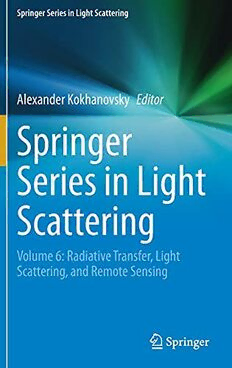Table Of ContentSpringer Series in Light Scattering
Alexander Kokhanovsky Editor
Springer
Series in Light
Scattering
Volume 6: Radiative Transfer, Light
Scattering, and Remote Sensing
Springer Series in Light Scattering
SeriesEditor
AlexanderKokhanovsky,VITROCISETBelgium,ALeonardoCompany,
Darmstadt,Germany
EditorialBoard
ThomasHenning,MaxPlanckInstituteforAstronomy,Heidelberg,Germany
GeorgeKattawar,TexasA&MUniversity,CollegeStation,USA
OlegKopelevich,ShirshovInstituteofOceanology,Moscow,Russia
Kuo-NanLiou,UniversityofCalifornia,LosAngeles,USA
MichaelMishchenko,NASAGoddardInstituteforSpaceStudies,NewYork,USA
LevPerelman,HarvardUniversity,Cambridge,USA
KnutStamnes,StevensInstituteofTechnology,Hoboken,USA
GraemeStephens,NASAJetPropulsionLaboratory,LosAngeles,USA
BartvanTiggelen,J.FourierUniversity,Grenoble,France
ClaudioTomasi,InstituteofAtmosphericSciencesandClimate,Bologna,Italy
The main purpose of is to present recent advances and progress in light scattering
mediaoptics.Thetopicisverybroadandincorporatessuchdiverseareasasatmo-
spheric optics, ocean optics, optics of close-packed media, radiative transfer, light
scattering, absorption, and scattering by single scatterers and also by systems of
particles, biomedical optics, optical properties of cosmic dust, remote sensing of
atmosphere and ocean, etc. The topic is of importance for material science, envi-
ronmentalscience,climatechange,andalsoforopticalengineering.Althoughmain
developmentsinthesolutionsofradiativetransferandlightscatteringproblemshave
beenachievedinthe20thcenturybyeffortsofmanyscientistsincludingV.Ambart-
sumian,S.Chandrasekhar,P.Debye,H.C.vandeHulst,G.Mie,andV.Sobolev,the
lightscatteringmediaopticsstillhavemanypuzzlestobesolvedsuchasradiative
transferincloselypackedmedia,3Dradiativetransferasappliedtothesolutionof
inverseproblems,opticsofterrestrialandplanetarysurfaces,etc.Alsoithasabroad
rangeofapplicationsinmanybranchesofmodernscienceandtechnologysuchas
biomedicaloptics,atmosphericandoceanicoptics,andastrophysics,tonameafew.
ItisplannedthattheSerieswillraisenovelscientificquestions,integratedataanal-
ysis,andoffernewinsightsinopticsoflightscatteringmedia.SPRINGERSeries
inLightScattering.
Moreinformationaboutthisseriesathttp://www.springer.com/series/15365
Alexander Kokhanovsky
Editor
Springer Series in Light
Scattering
Volume 6: Radiative Transfer, Light
Scattering, and Remote Sensing
Editor
AlexanderKokhanovsky
VitrocisetBelgium
Darmstadt,Hessen,Germany
ISSN2509-2790 ISSN2509-2804 (electronic)
SpringerSeriesinLightScattering
ISBN978-3-030-71253-2 ISBN978-3-030-71254-9 (eBook)
https://doi.org/10.1007/978-3-030-71254-9
©TheEditor(s)(ifapplicable)andTheAuthor(s),underexclusivelicensetoSpringerNature
SwitzerlandAG2021
Thisworkissubjecttocopyright.AllrightsaresolelyandexclusivelylicensedbythePublisher,whether
thewholeorpartofthematerialisconcerned,specificallytherightsoftranslation,reprinting,reuse
ofillustrations,recitation,broadcasting,reproductiononmicrofilmsorinanyotherphysicalway,and
transmissionorinformationstorageandretrieval,electronicadaptation,computersoftware,orbysimilar
ordissimilarmethodologynowknownorhereafterdeveloped.
Theuseofgeneraldescriptivenames,registerednames,trademarks,servicemarks,etc.inthispublication
doesnotimply,evenintheabsenceofaspecificstatement,thatsuchnamesareexemptfromtherelevant
protectivelawsandregulationsandthereforefreeforgeneraluse.
Thepublisher,theauthorsandtheeditorsaresafetoassumethattheadviceandinformationinthisbook
arebelievedtobetrueandaccurateatthedateofpublication.Neitherthepublishernortheauthorsor
theeditorsgiveawarranty,expressedorimplied,withrespecttothematerialcontainedhereinorforany
errorsoromissionsthatmayhavebeenmade.Thepublisherremainsneutralwithregardtojurisdictional
claimsinpublishedmapsandinstitutionalaffiliations.
ThisSpringerimprintispublishedbytheregisteredcompanySpringerNatureSwitzerlandAG
Theregisteredcompanyaddressis:Gewerbestrasse11,6330Cham,Switzerland
Contents
√
(cid:2) Law: Centennial of the First Exact Result of Classical
RadiativeTransferTheory ......................................... 1
V.V.Ivanov
SolarHeatingoftheCryosphere:SnowandIceSheets ................ 53
LeonidA.DombrovskyandAlexanderA.Kokhanovsky
Stereological Methods in the Theory of Light Scattering
byNonsphericalParticles .......................................... 111
AlekseyMalinka
InverseMethodsinStudiesofTerrestrialAtmosphere ................ 175
MichaelYu.Kataev
Index ............................................................. 195
v
√
(cid:2)
Law: Centennial of the First Exact
Result of Classical Radiative Transfer
Theory
V.V.Ivanov
1 Introduction
√
Nowadaysprobablynobodyknowswhenandwheretheterm“ (cid:2)law√”wascoined.
But as early as in 1975 in the title of one of the papers we find “ (cid:2) revisited”
(FrischandFrisch1975).Hencesomeo√nehasalreadyvisiteditearlier.Andthen√it
started:“Analternativederivationfor (cid:2)”(La√ndiDegl’Innocenti1979),“The (cid:2)
law”(Hubeny1987),“...Agenera√lizationofthe (cid:2)law”(LandiDegl’Innocentiand
Bommier19√94),“Ageneralized (cid:2)-law ”(ŠteˇpánandBommier2007),“...general
formo√fthe (cid:2)law”(Grachev2014)and,finally,thetitleo√fthisdocumentinitially
was“ (cid:2)law:retrospective”.Well,andwhatindeedisthis (cid:2),andwhydoesitneed
somany√generalizations?
The (cid:2)lawinitsusualastrophysicalformulationistheassertionthatthedegreeof
excitationoftwo-levelatomsattheboundaryofsemi-infiniteisoth√ermalatmosphere
is lover than its equilibrium Boltzmann value by a factor of 1/ (cid:2). Here, (cid:2) is the
probabilityofdestructionofaphotonofresonancelineperscatteringundergoneby
photonsinitsspecificrandomwalkintheatmosphere.Thespecificfeatureofthis
walkiscausedbythepossibilityoftinychangesofphotonfrequencyuponscattering.
Thisleadstodrasticchangesintheirmeanfreepathlength;averagedovertheline,
itisinfinite(thesocalledLévyflights).Instellaratmospheres,forstrongresonance
linesonehas(cid:2)(cid:3)1.Theresultisthat,duetotheescapeofradiation,therearelarge
deviationsfromthermodynamicequilibriumneartheboundaryoftheatmosphere.
Elucidatingthestructureofthenon-equilibriumopticallythickboundarylayeristhe
keyproblemofthetheoryofstellaratmospheres.Amathematicallysimilarproblemis
thecalculationofthermalequilibriumofamodelsolaratmosphereheatedfrombelow
byradiationoriginatinginSun’sinterior.Polarizationoftheradiationemergingfrom
B
V.V.Ivanov( )
St.PetersburgUniversity,SaintPetersburg,Russia
e-mail:[email protected]
©TheAuthor(s),underexclusivelicensetoSpringerNatureSwitzerlandAG2021 1
A.Kokhanovsky(ed.),SpringerSeriesinLightScattering,SpringerSeries
inLightScattering,https://doi.org/10.1007/978-3-030-71254-9_1
2 V.V.Ivanov
ascatteringatmosphe√realsobearsvaluableinformationonitsphysics.Incalculating
thispolarization,the (cid:2)law(inageneralizedform)isalsohelpful.
Thispaperpresentsanoverviewofevolution(spanningacentury)ofinvestiga-
tionsofseveralradiativetransferproblems.Itmayalsobeconsideredasanauthor’s
personalaccount(itseems,somewhatimmodest)ono√neofhisresearchfields.
Assertions that are known in astrophysics as “the (cid:2) law”, are mathematically
equivalenttothisone.IfwehavetheWiener–Hopfintegralequation
(cid:2)∞
S(τ)=(1−(cid:2)) K(τ −τ(cid:5))S(τ(cid:5))dτ(cid:5)+(cid:2) (1)
0
withsymmetricnon-negativenormalizedtounitykernelfunction K(τ),sothat
(cid:2)∞
K(−τ)= K(τ), K(τ)≥0, K(τ)dτ =1, (2)
−∞
then √
S(0)= (cid:2), S(∞)=1. (3)
√
However,theforminwhich (cid:2)appearsinastrophysicalliteratureisusuallydifferent,
andsoitsessenceremainsunclear.
AlongwithEq.(1)itisnaturaltoconsideritslimitingformfor(cid:2)=0,i.e.homo-
geneousequation
(cid:2)∞
S (τ)= K(τ −τ(cid:5))S (τ(cid:5))dτ(cid:5), (4)
h h
0
thesolutionofwhichwillbenormalizedsothat
S (0)=1. (5)
h
Comparisonof(1)and(3)with(4)–(5)showsthat
S(τ)
S (τ)= lim √ . (6)
h (cid:2)→0 (cid:2)
Asymptoticbehaviorofthesolution√ofhomogeneousequation(4)forτ →∞may
belookedatasacounterpartofthe (cid:2)lawforthelimitingcase(cid:2)=0.
Physical significance of Eqs. (1) and (4), kernel function K(τ), solutions S(τ)
andS (τ),aswellastheparameter(cid:2), 0≤(cid:2)≤1,invariousastrophysicalproblems
h
(and all the m(cid:3)ore in problems(cid:4)of other branches of physics) differ. In terminology
and notation τ, (cid:2), H(μ) etc. we follow astrophysical tradition (mainly Western,
ratherthanRussian).
√
(cid:2)Law:CentennialoftheFirstExactResultofClassicalRadiativeTransferTheory 3
Fig.1 Behaviorofsolutions
ofEqs.(1)and(4)witha
probabilistickernelK(τ)
BehaviorofsolutionsS(τ)oftheEq.(1)withaprobabilistickernelK(τ)aswell
asthatofthecorrespondinghomogeneousequation(4),S (τ),isillustratedinFig.1.
h
Theoutlineofthepaperisasfollows.Section2isanelementaryintroductionto
the solution√of the Wiener–Hopf equations with probabilistic kernels. The deriva-
tion of the (cid:2) law is provided, one of the simplest among a multitude of all the
a√vailable. Section3 presents a brief historical overview of the first appearance of
(cid:2)inastrophysics.InSect.4wediscussspecificfeaturesofmultiplescatteringof
photonsofresonancelinesindilutegaseousmedia.Thenotionoftheboundarylayer
isintroducedanditsstructureisbrieflyoutlined.InSect.5weconsiderradiationin
aresonancelineemergingfromsemi-infinitescatteringatmosphere.Crucialroleof
continuumabsorptioninqu√enchingmultiplescatteringandhenceinlineformation
isdiscussed.InSect.6the (cid:2)lawisusedasthebasisinstudyingscalingofradia-
tionfieldsinatmospheresoffiniteopticalthickness.Thelarge-scaledescriptionof
transferoflineradiation√isintroduced.InSect.7ween√umeratethemethodsthathas
beenusedtoderivethe (cid:2)law.Generalizationsofthe (cid:2)lawnecessaryfortreating
polarizedradiationarethesubjectofSect.8.Problemsofbothnon-magneticmulti-
pleresonancescatteringandsca√tteringinatmosphereswithweakmagneticfieldsare
brieflydiscussed.InSect.9the (cid:2)lawcombinedwiththeasymptoticsolutionofthe
homogeneousEq.(4)areusedasthebasisforconstructinganapproximatesolutionof
4 V.V.Ivanov
theWiener–Hopfequation(1)thatdescribesthesocalledLevýflights(kernelswith
“tails”decreasingsoslowlythateventhefirstmomentofK(τ)diverges).Finally,in
Sect.10wesummarizetheresults.
2 MathematicalPrologue
2.1 TheGreenFunction
LetG(τ,τ )betheGreenfunctionofEq.(1),i.e.thesolutionoftheequation
1
(cid:2)∞
G(τ,τ )=(1−(cid:2)) K(τ −τ(cid:5))G(τ(cid:5),τ )dτ(cid:5)+δ(τ −τ ), (7)
1 1 1
0
whereδ(τ −τ )isthedelta–function.Let,further,G (τ)bethevalueoftheGreen
1 0
functionforτ =0(surfaceGreenfunction;physically—thesourceattheboundary
1
ofthemedium):
G (τ)≡G(τ,0)=G(0,τ). (8)
0
Simpleprobabilisticconsiderationsshowthat
(cid:2)τ
G(τ,τ )= G (τ −t)G (τ −t)dt, τ =min(τ,τ ). (9)
1 0 0 1 1
0
Somewhatunexpectedly,G0appearsheren√on-linearly.Asweshallseeshortly,itis
thisnon-linearitywhichisattherootofthe (cid:2)law,non-linearityoftheH–equation
etc. Equation (9) reveals the key role of the surface Green function G (τ) in all
0
half-spaceproblems.
Physically,Eq.(9)isnearlyobvious.Transferofparticle(inourcase,aphoton)
occurs along a trajectory. Let t be the depth at which the trajectory approaches
the surface most (the highest point of the trajectory, if the boundary is at the top).
Evidentlyt ≤min(τ,τ ).Atthispointtscatteringoccurs,sinceotherwisethephoton
1
wouldcontinuetoapproachtheboundary.Thisscatteringeventdividesthetrajectory
leadingfromτ toτ intwoparts.Theprobabilityoftransitionfromτ tot alongthe
1 1
firstpartofthetrajectoryisevidentlyG(0,τ −t),sincepresenceofthelayersabove
1
t is not felt, and otherwise the trajectory is arbitrary. After scattering at t, random
walkcontinues,againwithoutintersectingthislevel.Hencewemayassumethata
newphotonisinjectedattheboundaryofahalf-space,andithastoarriveatτ −t.
ThecorrespondingtransitionprobabilityisobviouslyG(τ −t,0).Sincethereisno
memory in the random walk, the total transition probability τ →τ along all the
1
trajectories with the highest point at t is the product of the transition probabilities

